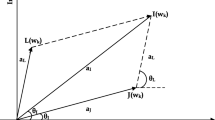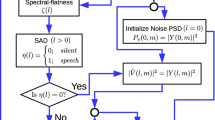Abstract
Conventional methods for noise suppression can successfully reduce stationary noise. However, non-stationary noise such as intermittent and impulsive noise cannot be sufficiently suppressed since these methods do not focus on temporal features of noise. This paper proposes a method for suppressing both stationary and non-stationary noise based on modulation spectrum analysis. Modulation spectra (MS) of the stationary, intermittent, and impulsive noise were investigated by using the time/frequency/modulation analysis techniques to characterize the MS features. These features were then used to suppress the stationary and non-stationary noise components from the observed signals. Using the proposed method, the direct-current components of the MS in the stationary noise, harmonicity of the MS in the intermittent noise, and higher modulation-frequency components of the MS in the impulsive noise were removed. The following advantages of the proposed method were confirmed: (1) sound pressure level of the noise was dramatically reduced, (2) signal-to-noise ratio of the noisy speech was improved, and (3) loudness, sharpness, and roughness of the restored speech were enhanced. These results indicate that the stationary as well as non-stationary noise can be successfully suppressed using the proposed method.
Access this chapter
Tax calculation will be finalised at checkout
Purchases are for personal use only
Similar content being viewed by others
References
Boll, S.: Suppression of acoustic noise in speech using spectral subtraction. IEEE Trans. Acoust. Speech Signal Process. 27, 113–120 (1979)
Takehara, R., Kawamura, A., Iiguni, Y.: Impulsive noise suppression using interpolated zero phase signal. In: APSIPA2017, pp. 1382–1389 (2017)
Zhiyao, D., Gautham, J.M., Paris, S.: Speech enhancement by online non-negative spectrogram decomposition in non-stationary noise environments. In: Proceedings of Interspeech 2012, pp. 595–598 (2012)
Stephan, D.E., Torsten, D.: Characterizing frequency selectivity for envelope fluctuations. J. Acoust. Soc. Am. 108, 1181 (2000)
Patterson, R., Nimmo-Smith, L., Holdsworth, J., Rice, P.: An auditory filter bank based on the gammatone function. Paper Presented at a Meeting of the IOC Speech Group on Auditory Modelling at RSRE, pp. 14–15 (1987)
Kondo, T., Amano, S., Sakamoto, S., Susuki, Y.: Development of familiarity-controlled word-lists (FW07). IEICE Tech. Rep. 107(436), 43–48 (2008)
Varga, A., Steeneken, J.M.H.: Assessment for automatic speech recognition: II. NOISEX-92: a database and an experiment to study the effect of additive noise on speech recognition systems. Speech Commun. 12(13), 247–251 (1993)
Atlas, L., Greenberg, S., Hermansky, H.: The Modulation Spectrum and Its Application to Speech Science and Technology. Interspeech Tutorial, Antwerp (2007)
Kanai, Y., Morita, S., Unoki, M.: Concurrent processing of voice activity detection and noise reduction using empirical mode decomposition and modulation spectrum analysis. In: Proceedings of INTERSPEECH, pp. 742–746 (2013)
Zwicker, F.: Psychoacoustics: Facts and Models. Springer, Heidelberg (2007). https://doi.org/10.1007/978-3-540-68888-4
Acknowledgments
This work was supported by the Secom Science and Technology Foundation by the Suzuki Foundation, and by a Grant in Aid for Innovative Areas (No. 16H01669, and 18H05004) from MEXT, Japan.
Author information
Authors and Affiliations
Corresponding authors
Editor information
Editors and Affiliations
Rights and permissions
Copyright information
© 2018 Springer Nature Switzerland AG
About this paper
Cite this paper
Isoyama, T., Unoki, M. (2018). Noise Suppression Method Based on Modulation Spectrum Analysis. In: Karpov, A., Jokisch, O., Potapova, R. (eds) Speech and Computer. SPECOM 2018. Lecture Notes in Computer Science(), vol 11096. Springer, Cham. https://doi.org/10.1007/978-3-319-99579-3_25
Download citation
DOI: https://doi.org/10.1007/978-3-319-99579-3_25
Published:
Publisher Name: Springer, Cham
Print ISBN: 978-3-319-99578-6
Online ISBN: 978-3-319-99579-3
eBook Packages: Computer ScienceComputer Science (R0)




